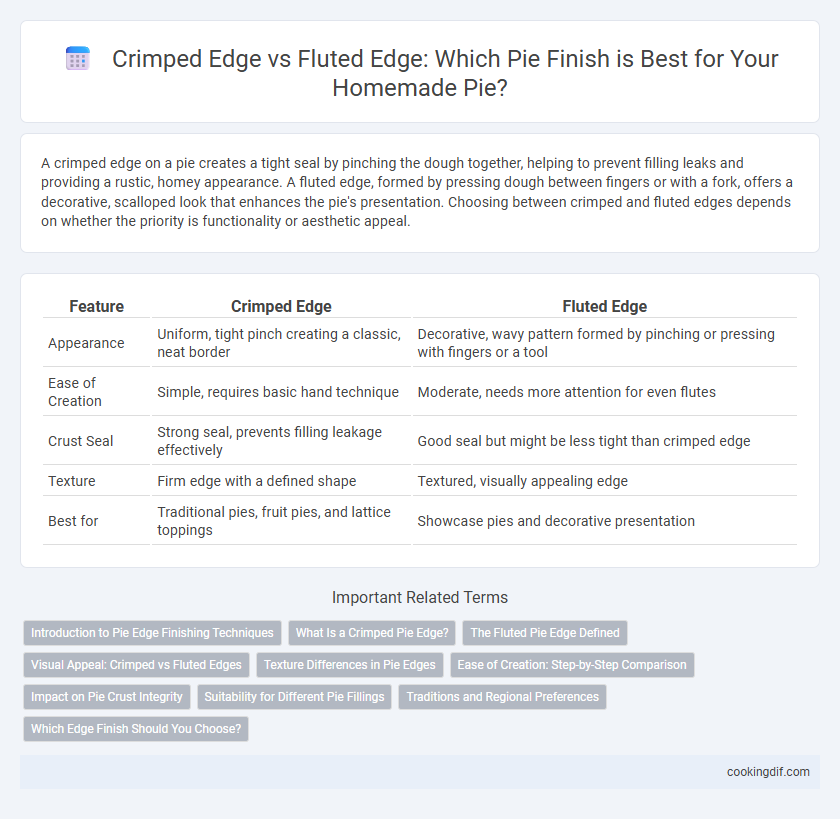A crimped edge on a pie creates a tight seal by pinching the dough together, helping to prevent filling leaks and providing a rustic, homey appearance. A fluted edge, formed by pressing dough between fingers or with a fork, offers a decorative, scalloped look that enhances the pie's presentation. Choosing between crimped and fluted edges depends on whether the priority is functionality or aesthetic appeal.
Table of Comparison
| Feature | Crimped Edge | Fluted Edge |
|---|---|---|
| Appearance | Uniform, tight pinch creating a classic, neat border | Decorative, wavy pattern formed by pinching or pressing with fingers or a tool |
| Ease of Creation | Simple, requires basic hand technique | Moderate, needs more attention for even flutes |
| Crust Seal | Strong seal, prevents filling leakage effectively | Good seal but might be less tight than crimped edge |
| Texture | Firm edge with a defined shape | Textured, visually appealing edge |
| Best for | Traditional pies, fruit pies, and lattice toppings | Showcase pies and decorative presentation |
Introduction to Pie Edge Finishing Techniques
Crimped edges and fluted edges are popular techniques for finishing pie crusts, enhancing both visual appeal and structural integrity. Crimped edges involve pinching the dough between fingers or a fork to create a textured, sealed border that prevents filling leakage during baking. Fluted edges are formed by pressing the dough between the thumb and index finger at regular intervals, producing elegant wave-like patterns that add a decorative touch while ensuring a firm seal.
What Is a Crimped Pie Edge?
A crimped pie edge is created by pinching the dough between your thumb and forefinger, forming a decorative, wavy pattern that seals the crust firmly. This technique enhances the pie's structural integrity, preventing filling leaks during baking, and provides a classic homemade appearance. Crimped edges differ from fluted edges, which are formed by pressing the dough against the pie plate with a tool or fingers, giving a more uniform and refined finish.
The Fluted Pie Edge Defined
The fluted pie edge is characterized by a decorative wave-like pattern created by pinching the dough between the thumb and forefinger, forming a series of uniform curves that enhance both aesthetics and crust texture. This edge style provides an elegant finish that holds pie fillings securely while promoting even browning along the rim. Unlike the simpler crimped edge, the fluted edge requires more skill but results in a visually appealing presentation ideal for fruit pies and tarts.
Visual Appeal: Crimped vs Fluted Edges
Crimped edges create a uniform, ridged pattern that enhances the classic, homemade look of a pie, providing a sturdy finish that holds filling securely. Fluted edges offer a more intricate and decorative appearance with delicate, wave-like patterns that elevate the visual sophistication of the pie. Both edge styles contribute to the aesthetic appeal, but crimped edges emphasize rustic charm, while fluted edges highlight refined craftsmanship.
Texture Differences in Pie Edges
Crimped edges create a dense, pressed pattern that offers a firm and slightly rustic texture, providing a sturdy seal to hold pie fillings securely. Fluted edges feature a series of smooth, wavy indentations that produce a delicate and decorative finish with a lighter, crisp texture. The choice between crimped and fluted edges impacts not only the pie's aesthetic but also the tactile experience of the crust when biting into it.
Ease of Creation: Step-by-Step Comparison
Crimped edges involve pinching the dough between fingers, offering a simple and quick finishing method ideal for beginners. Fluted edges require pressing the dough against a guide, such as a pie tin, creating a uniform, decorative pattern but demanding more precision and practice. The crimped edge excels in ease and speed, while the fluted edge provides a polished look with slightly increased complexity.
Impact on Pie Crust Integrity
Crimped edges provide a tighter seal by pinching the dough together, enhancing pie crust integrity and reducing the risk of filling leakage during baking. Fluted edges create a decorative, scalloped border that maintains structural stability while offering a more delicate finish to the crust. Choosing between crimped and fluted edges depends on the desired balance between durability and aesthetic appeal in pie crusts.
Suitability for Different Pie Fillings
Crimped edges provide a tighter seal, making them ideal for juicy fillings like fruit pies and berry mixes by preventing leakage during baking. Fluted edges create an attractive, decorative finish that suits thicker fillings such as custards or cream pies, where minimal juice release is expected. Choosing between crimped and fluted edges depends on the pie's moisture content and the desired presentation.
Traditions and Regional Preferences
Crimped edges are traditionally favored in American pies, providing a rustic, homemade appearance that also helps seal the filling securely. Fluted edges, often preferred in European baking, create a more decorative and refined look, highlighting regional artistry and attention to pastry detail. These finishing techniques reflect cultural heritage and regional baking customs, influencing pie presentation and texture across different culinary traditions.
Which Edge Finish Should You Choose?
Crimped edges create a tight, decorative seal that helps prevent the filling from leaking during baking, making them ideal for juicy pies like fruit or custard. Fluted edges offer a classic, scalloped appearance that enhances visual appeal and crispness but may be less effective at sealing compared to crimping. Choose crimped edges for durability and filling retention, while fluted edges provide an elegant presentation suited for drier or pre-baked pie crusts.
Crimped edge vs fluted edge for pie finishing Infographic

 cookingdif.com
cookingdif.com